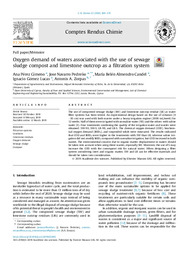Por favor, use este identificador para citar o enlazar este ítem:
https://hdl.handle.net/11000/34747Registro completo de metadatos
| Campo DC | Valor | Lengua/Idioma |
|---|---|---|
| dc.contributor.author | PÉREZ-GIMENO, ANA | - |
| dc.contributor.author | Navarro-Pedreño, Jose | - |
| dc.contributor.author | Almendro-Candel, María Belén | - |
| dc.contributor.author | Gómez Lucas, Ignacio | - |
| dc.contributor.author | Zorpas, Antonis | - |
| dc.contributor.other | Departamentos de la UMH::Agroquímica y Medio Ambiente | es_ES |
| dc.date.accessioned | 2025-01-16T19:47:56Z | - |
| dc.date.available | 2025-01-16T19:47:56Z | - |
| dc.date.created | 2019-03 | - |
| dc.identifier.citation | Comptes rendus. Chimie, 22 (2019) 269-275 | es_ES |
| dc.identifier.issn | 1878-1543 | - |
| dc.identifier.issn | 1631-0748 | - |
| dc.identifier.uri | https://hdl.handle.net/11000/34747 | - |
| dc.description.abstract | The use of composted sewage sludge (SW) and limestone outcrop residue (LR) as water f ilter systems has been tested. An experimental design based on the use of columns (0 e30 cm) was used with both wastes under a heavy irrigation regime (2000 mL/week) for 12 weeks. Half of themwere irrigated with nonsaline water (NS) and the others with saline water (S). Four treatments combining the quality of the irrigation water and wastes were obtained: SW-NS, SW-S, LR-NS, and LR-S. The chemical oxygen demand (COD), biochemical oxygen demand (BOD5), and suspended solids were measured. The results indicated that COD and BOD5 were higher in the treatments with SW than LR, whereas saline irrigation did not modify BOD5 compared with nonsaline irrigation, but COD increased in both wastes. The environmental concern due to organic matter displacement in waters should be taken into account when using these wastes, especially SW. Moreover, the use of S may increase the COD with the consequent risk for natural water. When designing a filter system considering inert and organic matter, SW and LR can be effective materials and should be taken into consideration. | es_ES |
| dc.format | application/pdf | es_ES |
| dc.format.extent | 7 | es_ES |
| dc.language.iso | eng | es_ES |
| dc.publisher | Elsevier | es_ES |
| dc.rights | info:eu-repo/semantics/openAccess | es_ES |
| dc.rights | Attribution-NonCommercial-NoDerivatives 4.0 Internacional | * |
| dc.rights.uri | http://creativecommons.org/licenses/by-nc-nd/4.0/ | * |
| dc.subject | Filtration systems | es_ES |
| dc.subject | Leachates | es_ES |
| dc.subject | Limestone residues | es_ES |
| dc.subject | Oxygen demand | es_ES |
| dc.subject | Sewage sludge | es_ES |
| dc.subject | Compost | es_ES |
| dc.subject.other | CDU::6 - Ciencias aplicadas::62 - Ingeniería. Tecnología | es_ES |
| dc.title | Oxygen demand of waters associated with the use of sewage sludge compost and limestone outcrop as a filtration system | es_ES |
| dc.type | info:eu-repo/semantics/article | es_ES |
| dc.relation.publisherversion | https://doi.org/10.1016/j.crci.2019.02.002 | es_ES |

Ver/Abrir:
10.1016j.crci.2019.02.002.pdf
564,46 kB
Adobe PDF
Compartir:
 La licencia se describe como: Atribución-NonComercial-NoDerivada 4.0 Internacional.
La licencia se describe como: Atribución-NonComercial-NoDerivada 4.0 Internacional.
.png)